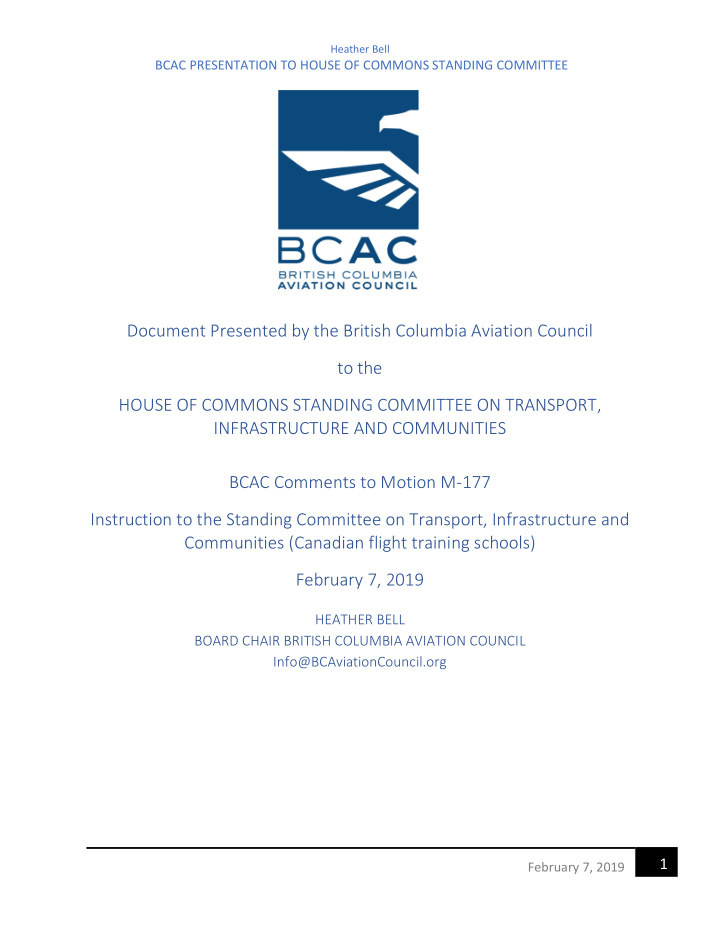



Heather Bell BCAC PRESENTATION TO HOUSE OF COMMONS STANDING COMMITTEE Document Presented by the British Columbia Aviation Council to the HOUSE OF COMMONS STANDING COMMITTEE ON TRANSPORT, INFRASTRUCTURE AND COMMUNITIES BCAC Comments to Motion M-177 Instruction to the Standing Committee on Transport, Infrastructure and Communities (Canadian flight training schools) February 7, 2019 HEATHER BELL BOARD CHAIR BRITISH COLUMBIA AVIATION COUNCIL Info@BCAviationCouncil.org 1 February 7, 2019
Heather Bell BCAC PRESENTATION TO HOUSE OF COMMONS STANDING COMMITTEE Ta Tabl ble of Cont ntent nts ABOUT BRITISH COLUMBIA AVIATION COUNCIL ..................................................................... 3 ABOUT HEATHER BELL ........................................................................................................... 3 LABOUR RESOURCE CRISIS ..................................................................................................... 3 WHY THE SHORTAGE ............................................................................................................. 4 BARRIERS TO SUCCESS AND RECOMMENDATIONS .................................................................. 4 Student funding .............................................................................................................................4 Recommendation: ................................................................................................................................................ 5 Flight Instructor Retention .............................................................................................................5 Recommendation ................................................................................................................................................. 5 Regulatory Impediments ................................................................................................................5 Recommendation ................................................................................................................................................. 5 Increase Industry Diversity: Outreach and recruitment of Women and Indigenous Peoples ..............6 Recommendation ................................................................................................................................................. 6 2 February 7, 2019
Heather Bell BCAC PRESENTATION TO HOUSE OF COMMONS STANDING COMMITTEE ABOUT BRITISH COLUMBIA AVIATION COUNCIL Aviation is critical to both maintaining and growing the British Columbia economy. Air transport supports British Columbians in their lives every day, not only as a means of personal transportation and for the movement of goods, but also for land use planning, research, wildlife tracking, critical aerial firefighting, medical evacuation and organ transfer. It is vital to note that many remote British Columbian communities are air access only for months at a time. The British Columbia Aviation Council is a 340 member-driven charitable organization established under the British Columbia Society Act. Our Mission is to promote, stimulate and encourage the development, growth and advancement of aviation and aerospace in British Columbia. ABOUT HEATHER BELL Heather Bell is the current chair of the British Columbia Aviation Council and has 36 years of experience in the aviation industry. Heather has worked as both a VFR and IFR operational Air Traffic Controller, and retired from NavCanada as the General Manager of the Vancouver Flight Information Region, where she was responsible for all Air Navigation Services provided in the province. Heather has also been a board member of the Aviation Leadership Foundation, sits as a member of the Federal Aviation Labour Shortage steering committee, consults to both Vancouver International Airport and Toronto Pearson Airport on their Master Plans. Industry recognitions include the Surrey Business Woman of the year in 2011 and the Northern Lights Award in Business for 2017. Heather is also the co-founder of an Aviation project entitled, “Give Them Wings , ” a program created to introduce careers in aviation (particularly pilot training), to Indigenous youth. LABOUR RESOURCE CRISIS As outlined by previous submissions, the Aviation and Aerospace sector is a vital economic driver for the Canadian economy, generating almost $30B in revenue and more than 200,000 direct and indirect jobs. Today Air Transport has become a “taken -for- granted” mode of transportation in the developed world. The looming human resource shortage across many 3 February 7, 2019
Heather Bell BCAC PRESENTATION TO HOUSE OF COMMONS STANDING COMMITTEE sectors of this industry is a substantial threat to the sustainability of Canadian Aviation and may have far-reaching negative impacts to the health and welfare of businesses, remote communities, and individuals. With respect to Pilots, it is estimated that by 2025, the Canadian industry will have a shortfall of 3000 pilots. At BCAC, our concern is with the imminent adverse and cascading effects. WHY THE SHORTAGE Historically the path to become a commercial pilot was somewhat predictable. The road was long, the price (both in dollars and personal sacrifice) was high, and the reward was not universal or guaranteed. Until fairly recently, there has been a sufficient number of people entering the pilot “pipeline” to ensure available staffing for airlines along each stage of career progression, and to meet the diverse array of industry needs. Before being hired by regional, corporate, or national airlines, newly licensed commercial pilots could expect to either “build time” by becoming Flight Instructors, or by moving north to fly in remote communities. With increasing levels of attrition at top airline levels, the trend over the past few years has seen this path for new pilots substantially shorten. While the cost of becoming a commercial pilot remains high, new pilots are now able to secure positions at the national air carrier level without spending the five or ten years as Flight Instructors or flying in remote communities, like in the past. Lower level air carriers are now struggling to attract, find, and keep qualified pilots for more than one or two years. Additionally, careers in aviation do not seem to have “the draw” they once did with fewer students choosing Aviation as a profession. Many organizations have been attempting to identify barriers to entry but it has proven to be inherently difficult to access individuals who chose alternate career paths. The focus of attention is on those who do enter the industry and struggle with challenging, unappealing working conditions and poor quality of life. BARRIERS TO SUCCESS AND RECOMMENDATIONS Student funding We have heard from both our Flight Training Units and student population that lack of access to sufficient student funding is the single greatest impediment to success. Currently student funding is provincially regulated and the available funding is not universally accessible across the country. For instance, in British Columbia, the funding for an aviation program is based on “weeks” of training rather than the cost of that training. On average, the cost to obtain a Canadian Commercial Pilot Licence with an Instructor Rating will exceed $75,000CAD, and yet the funding available for a student pursuing this will be less than $14,000. Other provinces do offer more financial aid than BC, but still not to the level required by most Canadian aviation 4 February 7, 2019
Recommend
More recommend